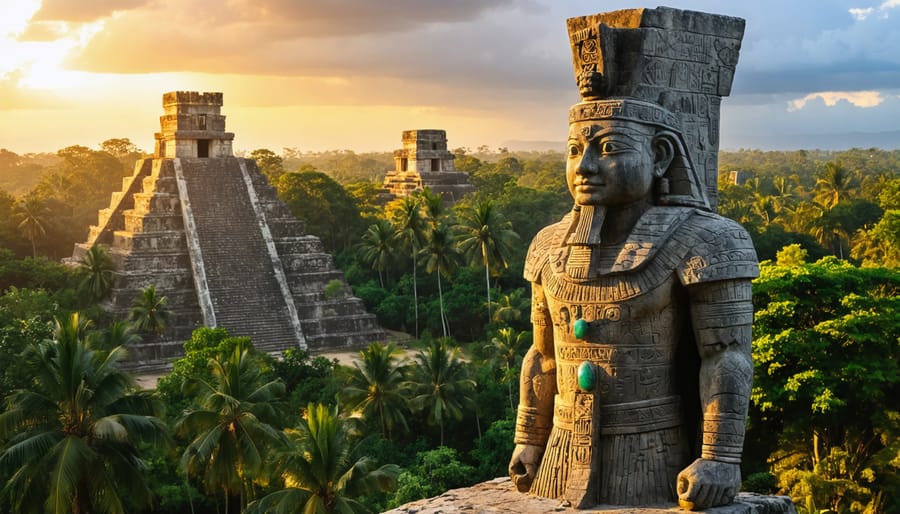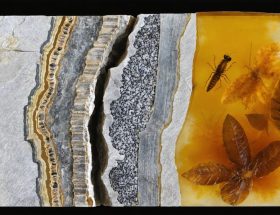Towering from ancient plazas and temple complexes, Mayan stone sculptures stand as masterful testimonies to one of history’s most sophisticated civilizations. These monumental works, showcasing remarkable preservation in stone, continue to captivate architects, artists, and scholars with their technical precision and symbolic depth.
Carved from limestone and volcanic rock between 2000 BCE and 1500 CE, Mayan sculptural works represent far more than mere decorative elements. Each piece served as a complex communication tool, encoding historical records, astronomical calculations, and divine narratives through intricate hieroglyphic inscriptions and iconographic programs.
The sculptors’ masterful understanding of stone properties enabled them to create works ranging from delicate relief panels to colossal portrait stelae, sometimes reaching heights of 20 feet or more. Their technical achievements in stone carving, achieved using only stone and wooden tools, remain impressive even by modern standards.
Today, these enduring monuments provide crucial insights into Mayan political structures, religious beliefs, and artistic innovations, while inspiring contemporary designers and architects to incorporate similar principles of permanence and cultural significance into their work.
The Sacred Materials of Mayan Sculpture
Limestone: The Foundation of Mayan Art
Limestone served as the cornerstone of Mayan sculptural arts, with its abundant availability throughout the Yucatan Peninsula shaping the civilization’s artistic legacy. As one of the most significant ancient stone materials, limestone offered Mayan artisans unique advantages that made it ideal for elaborate carvings and monumental works.
The stone’s relatively soft nature when freshly quarried allowed sculptors to work efficiently with simple tools, while its tendency to harden upon exposure to air ensured the longevity of finished pieces. This natural characteristic enabled the creation of intricately detailed reliefs and free-standing sculptures that have endured for centuries.
The region’s high-quality limestone deposits varied in color from creamy white to pale gray, providing artists with consistent working material. Mayan sculptors expertly exploited the stone’s natural properties, using its uniform grain structure to achieve precise details in hieroglyphic inscriptions and figurative works. The material’s durability in the tropical climate of Mesoamerica has preserved countless masterpieces, offering modern viewers a window into the sophisticated artistic achievements of this remarkable civilization.
Volcanic Stone and Jade in Religious Artifacts
Beyond limestone and sandstone, Maya sculptors worked extensively with volcanic materials and jade, each carrying profound spiritual significance. Volcanic stone, particularly basalt and obsidian, was prized for its durability and dark, imposing appearance. These materials were often reserved for creating sculptures of rulers and deities, as their eternal nature symbolized power and immortality.
Jade held exceptional importance in Maya culture, representing life, fertility, and royal power. Sculptors transformed this precious stone into elaborate masks, pendants, and ceremonial objects. The stone’s natural green color symbolized maize, water, and the center of the universe in Maya cosmology. Artisans developed sophisticated techniques to work with jade’s exceptional hardness, using string saws and abrasives to achieve intricate details.
The combination of volcanic stone and jade in single artifacts was particularly significant, representing the duality of life and death, earth and sky. These composite sculptures often appeared in royal tombs and ceremonial centers, where their symbolic power was believed to facilitate communication between the material and spiritual worlds.
Symbolic Elements in Mayan Stone Carvings
Royal Iconography and Power Symbols
Mayan rulers utilized stone sculpture as a powerful medium to assert their divine authority and legitimacy. These elaborate carvings typically depicted kings in commanding poses, adorned with intricate regalia including elaborate headdresses, ceremonial bars, and sacred symbols of power. The rulers were often shown wearing jade ornaments and carrying symbols of authority such as the K’awiil scepter, which represented lightning and divine kingship.
Common iconographic elements included the ruler seated on throne cushions, standing triumphantly over captured enemies, or performing important ritual ceremonies. Their faces were carved in profile, following strict artistic conventions that emphasized their divine lineage and connection to the gods. Many sculptures incorporated hieroglyphic texts that recorded the ruler’s genealogy, military victories, and important dates in the Maya calendar.
The scale of these royal portraits was intentionally imposing, with some stelae reaching heights of over 20 feet. Placement was equally significant, with sculptures strategically positioned in public spaces and temple complexes to maximize their visual impact. The combination of size, location, and intricate detail served to reinforce the ruler’s position as an intermediary between the earthly and divine realms.
These stone monuments weren’t merely decorative; they functioned as powerful propaganda tools, documenting and legitimizing the ruler’s right to govern through both artistic representation and written text.
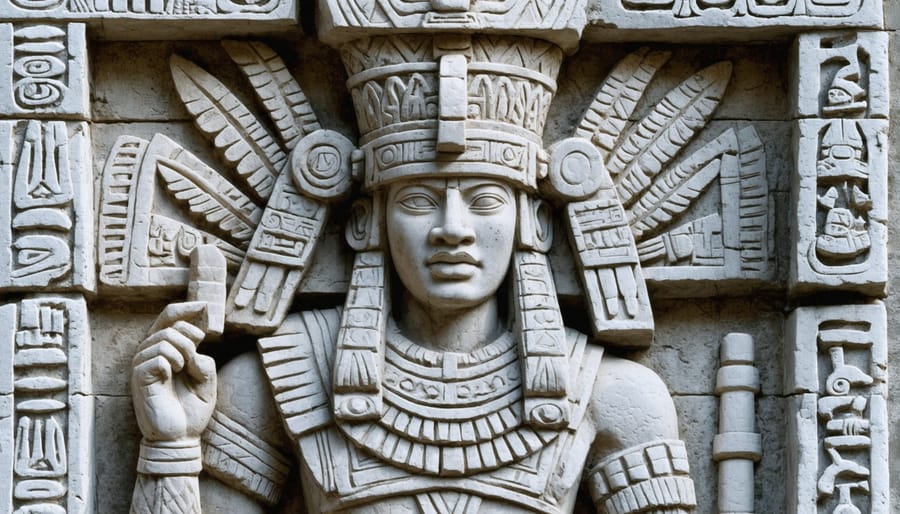
Religious Motifs and Deities
Religious beliefs permeated every aspect of Maya culture, and their stone sculptures served as powerful manifestations of their spiritual world. The Maya carved elaborate representations of their deities, often depicting them with distinct attributes and symbols that identified their divine roles. Common among these were Chaak, the rain god, recognizable by his long nose and serpentine features, and Kukulcan, the feathered serpent deity, whose image adorned many temple facades.
Sculptors frequently incorporated supernatural beings known as way spirits, which represented the animal companions of gods and powerful humans. These figures often appeared in transitional states between human and animal forms, reflecting the Maya belief in spiritual transformation. Ritual objects, such as ceremonial bars and sacrificial bowls, were also carved from stone and featured intricate religious iconography.
The placement of religious sculptures within Maya architecture was carefully planned, with specific deities positioned according to cardinal directions and celestial alignments. Stelas, tall stone slabs erected in city centers, combined portraits of rulers with religious symbolism, reinforcing the divine right of kingship. Many of these monuments included hieroglyphic texts describing religious ceremonies and important ritual dates.
The artistic treatment of these religious subjects demonstrated remarkable consistency across different Maya cities, suggesting a shared understanding of religious iconography throughout the civilization. Modern studies of these sculptures continue to reveal new insights into Maya cosmology and spiritual practices.
Carving Techniques and Craftsmanship
Traditional Tools and Methods
Mayan sculptors employed a remarkable array of tools and methods to create their intricate stone masterpieces, relying primarily on stone-on-stone techniques. The most common implements included hammerstones made from harder materials like basalt, chert chisels, and obsidian blades for detailed work. These basic tools, combined with advanced stone preservation techniques, enabled artisans to create works that have endured for centuries.
The sculptural process typically began with rough shaping using hammerstones, followed by increasingly precise refinements with smaller tools. Craftsmen would carefully strike the stone at specific angles to remove material in controlled flakes. For intricate details and finishing work, they employed abrasive materials like sand and water, creating smooth surfaces through patient rubbing motions.
Archaeological evidence suggests that wooden mallets and copper tools were also used, though few examples have survived. The Mayans demonstrated remarkable ingenuity in working with different stone types, adapting their techniques based on the material’s hardness and natural characteristics. Their methods proved so effective that many of their techniques continue to influence modern stone carving practices.
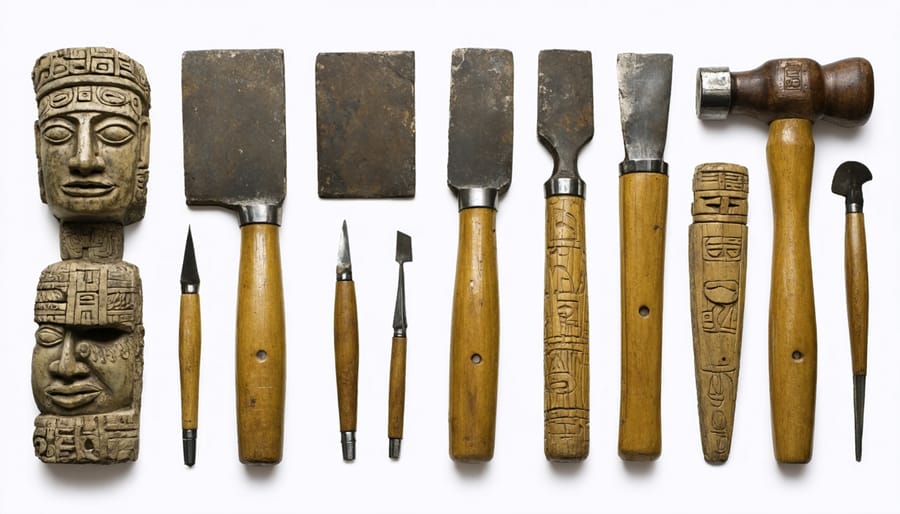
Modern Stone Carving Inspired by Mayan Traditions
Contemporary stone artisans are breathing new life into ancient Mayan carving traditions, creating modern masterpieces that honor historical techniques while embracing innovative approaches. Today’s craftspeople study the intricate relief carvings and symbolic patterns found in archaeological sites like Copán and Palenque, incorporating these traditional elements into contemporary architectural features and sculptural works.
Modern stone carvers utilize both traditional hand tools and advanced technology, striking a balance between ancient wisdom and current capabilities. While power tools and diamond-tipped instruments have expedited certain processes, many artisans still employ traditional chisels and hammers for detailed work, maintaining the authentic spirit of Mayan craftsmanship.
These contemporary works often feature in upscale resorts, cultural centers, and private residences throughout Mexico and Central America, where they serve as striking reminders of the region’s rich artistic heritage. Modern interpretations frequently blend classical Mayan motifs with contemporary design elements, creating pieces that resonate with both historical significance and current aesthetic sensibilities.
The revival of Mayan-inspired stone carving has also sparked interest in sustainable practices, with artisans selecting locally sourced limestone and other traditional materials, much like their ancient predecessors did centuries ago.
Legacy and Modern Applications
Contemporary Architectural Influences
The enduring legacy of Mayan stone sculpture continues to shape contemporary architecture and design. Modern architects and designers draw inspiration from the intricate patterns, geometric precision, and symbolic elements found in ancient Mayan stonework. This influence is particularly evident in Latin American architecture, where buildings incorporate stepped facades, angular geometry, and decorative stone elements that echo Mayan temples and monuments.
Notable examples include the National Museum of Anthropology in Mexico City, where the building’s design features massive stone pillars and carved reliefs that pay homage to Mayan architectural traditions. Similarly, luxury resorts throughout the Yucatan Peninsula integrate Mayan-inspired stone sculptures and decorative elements to create authentic cultural connections.
The sustainable aspects of Mayan stone construction techniques also resonate with modern green building practices. Contemporary architects appreciate the durability and thermal properties of stone, implementing these ancient wisdom-inspired solutions in innovative ways. Urban developments increasingly incorporate stone sculpture elements that reference Mayan motifs, from abstract interpretations in corporate spaces to faithful reproductions in cultural centers.
This architectural renaissance demonstrates how ancient Mayan stone craftsmanship continues to inspire sustainable, culturally rich design solutions in the 21st century.
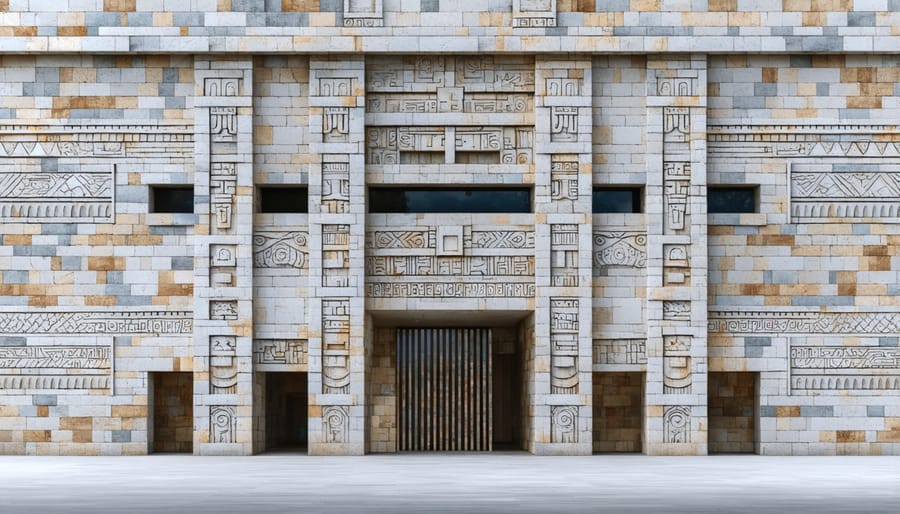
Preserving Ancient Techniques
Modern efforts to preserve traditional Mayan stone carving techniques represent a vital aspect of cultural heritage preservation. Today, skilled artisans in Mexico and Central America maintain these ancient practices through apprenticeship programs and dedicated workshops. These initiatives combine traditional knowledge with contemporary conservation methods to ensure the survival of authentic Mayan stoneworking techniques.
Master carvers work with limestone and jade using tools similar to those employed by their ancestors, including obsidian blades and stone hammers, while also incorporating modern tools when appropriate. Documentation plays a crucial role, with detailed recordings of techniques, tool usage, and material selection being preserved for future generations.
Several cultural institutions and indigenous communities have established training centers where young artists learn the intricate processes of stone selection, carving techniques, and sacred symbolism. These programs not only preserve ancient methods but also create economic opportunities for local communities while maintaining the authenticity of Mayan artistic traditions.
The preservation efforts extend beyond technical skills to include the spiritual and cultural significance of stone carving, ensuring that both the tangible and intangible aspects of this heritage continue to thrive.
The enduring legacy of Mayan stone sculpture extends far beyond its historical significance, continuing to influence contemporary art, architecture, and cultural expression throughout the Americas and beyond. These masterful works have not only preserved the rich narratives of Mayan civilization but have also inspired countless generations of artists and craftsmen in their pursuit of excellence in stone carving.
Modern-day sculptors and architects frequently draw inspiration from Mayan techniques and motifs, incorporating them into contemporary designs that bridge ancient wisdom with current aesthetics. The precise stone-working methods developed by Mayan artisans remain relevant today, particularly in the restoration of historical monuments and the creation of new works that honor these traditional practices.
The influence of Mayan stone sculpture is especially evident in contemporary Central American art, where local artists continue to explore and reinterpret classical Mayan themes and patterns. This cultural renaissance has sparked renewed interest in traditional stone-working techniques, leading to educational programs and workshops that preserve these ancient skills for future generations.
Beyond artistic practice, Mayan stone sculptures continue to provide valuable insights into sustainable building methods and the durability of natural stone as a construction material. Their remarkable preservation over centuries stands as testament to the superior craftsmanship and deep understanding of materials that characterized Mayan stone artistry, offering valuable lessons for modern construction and conservation efforts.

